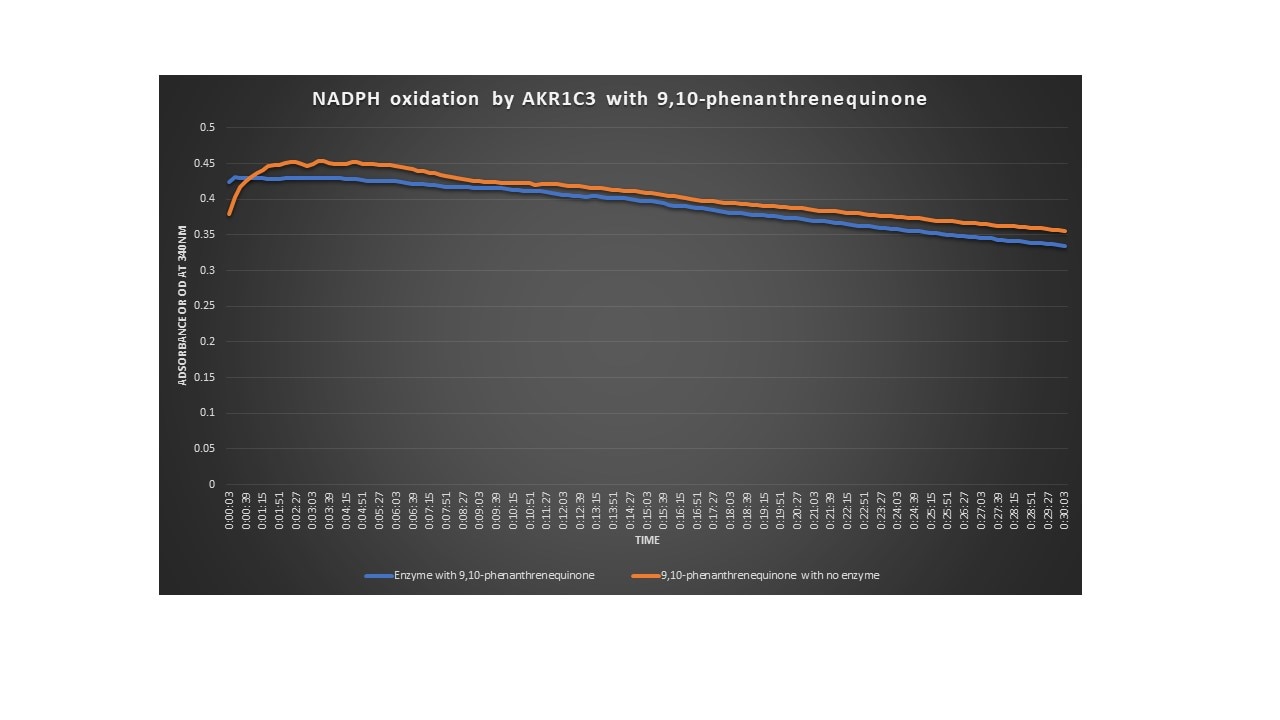Recombinant Human Aldo-keto Reductase 1C3/AKR1C3 Protein, CF
Recombinant Human Aldo-keto Reductase 1C3/AKR1C3 Protein, CF Summary
Product Specifications
Asp2-Tyr323, with an N-terminal Met and 6-His tag
Analysis
Product Datasheets
Carrier Free
CF stands for Carrier Free (CF). We typically add Bovine Serum Albumin (BSA) as a carrier protein to our recombinant proteins. Adding a carrier protein enhances protein stability, increases shelf-life, and allows the recombinant protein to be stored at a more dilute concentration. The carrier free version does not contain BSA.
In general, we advise purchasing the recombinant protein with BSA for use in cell or tissue culture, or as an ELISA standard. In contrast, the carrier free protein is recommended for applications, in which the presence of BSA could interfere.
7678-DH
| Formulation | Supplied as a 0.2 μm filtered solution in Tris, NaCl, Brij and Glycerol. |
| Shipping | The product is shipped with polar packs. Upon receipt, store it immediately at the temperature recommended below. |
| Stability & Storage: | Use a manual defrost freezer and avoid repeated freeze-thaw cycles.
|
Assay Procedure
- Assay Buffer: 100 mM Sodium Phosphate, pH 6.0
- Recombinant Human Aldo‑keto Reductase 1C3/AKR1C3 (rhAKR1C3) (Catalog # 7678-DH)
- 9,10-Phenanthrenequinone (PQ) (Sigma, Catalog # 156507), 5 mM stock in N,N-Dimethylformamide
- beta -Nicotinamide adenine dinucleotide phosphate reduced tetrasodium salt ( beta -NADPH) (Sigma, Catalog # N7505), 10 mM in deionized water
- UV Plate (Costar, Catalog # 3635)
- Plate Reader (Model: SpectraMax Plus by Molecular Devices) or equivalent
- Dilute rhAKR1C3 to 20 μg/mL in Assay Buffer.
- Prepare a Reaction Mixture containing 40 μM PQ and 400 μM beta -NADPH in Assay Buffer.
- In a plate, load 50 μL of 20 μg/mL rhAKR1C3, and start the reaction by adding 50 μL of Reaction Mixture. Include a Substrate Blank containing 50 μL of Assay Buffer and 50 μL of Reaction Mixture.
- Read at an absorbance of 340 nm in kinetic mode for 5 minutes.
- Calculate specific activity:
|
Specific Activity (pmol/min/µg) = |
Adjusted Vmax* (OD/min) x -1 x well volume (L) x 1012 pmol/mol |
| ext. coeff** (M-1cm-1) x path corr.*** (cm) x amount of enzyme (µg) |
*Adjusted for Substrate Blank
**Using the extinction coefficient 6270 M-1cm-1
***Using the path correction 0.32 cm
Note: the output of many spectrophotometers is in mOD Per Well:
- rhAKR1C3: 1 μg
- PQ: 20 μM
- beta -NADPH: 200 μM
Reconstitution Calculator
Background: Aldo-keto Reductase 1C3/AKR1C3
AKR1C3 is a member of the aldo-keto reductase (AKR) superfamily. It catalyzes oxidation/reduction reactions at the 3-alpha, 20-alpha, and 17-beta positions of steroids (1). It is also known as Prostaglandin F synthase as it reduces prostaglandin D2 to F2, and therefore may play a role in allergic conditions such as asthma (2). Elevated expression of AKR1C3 in endometrium that results in enhanced estrogen action may lead to endometrial cancer (3). It is also up‑regulated in squamous cell carcinoma of head and neck (4). AKR1C3 is found to be a novel suppressor of cell differentiation that provides a plausible target for the non-cyclooxygenase-dependent antineoplastic actions of nonsteroidal anti-inflammatory drugs (5).
- Penning, T. M. et al. (2000) Biochem J. 351:67.
- Suzuki-Yamamoto, T. et al. (1999) FEBS Lett. 462:335.
- Rizner, T. L. et al. (2006) Mol. Cell. Endocrinol. 248:126.
- Li, S. et al. (2004) Br. J. Cancer 90:1093.
- Desmond, J. C. et al. (2003) Cancer Res. 63:505.
Product Specific Notices
Coomassie is a registered trademark of Imperial Chemical Industries Ltd.Citation for Recombinant Human Aldo-keto Reductase 1C3/AKR1C3 Protein, CF
R&D Systems personnel manually curate a database that contains references using R&D Systems products. The data collected includes not only links to publications in PubMed, but also provides information about sample types, species, and experimental conditions.
1 Citation: Showing 1 - 1
-
Adipocytes Sequester and Metabolize the Chemotherapeutic Daunorubicin
Authors: X Sheng, JH Parmentier, J Tucci, H Pei, O Cortez-Tol, CM Dieli-Conw, MJ Oberley, M Neely, E Orgel, SG Louie, SD Mittelman
Mol. Cancer Res., 2017-11-08;0(0):.
Applications: Bioassay
FAQs
No product specific FAQs exist for this product, however you may
View all Proteins and Enzyme FAQsReviews for Recombinant Human Aldo-keto Reductase 1C3/AKR1C3 Protein, CF
Average Rating: 5 (Based on 1 Review)
Have you used Recombinant Human Aldo-keto Reductase 1C3/AKR1C3 Protein, CF?
Submit a review and receive an Amazon gift card.
$25/€18/£15/$25CAN/¥75 Yuan/¥2500 Yen for a review with an image
$10/€7/£6/$10 CAD/¥70 Yuan/¥1110 Yen for a review without an image
Filter by:


